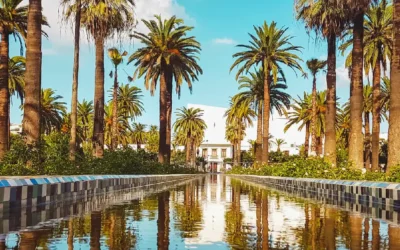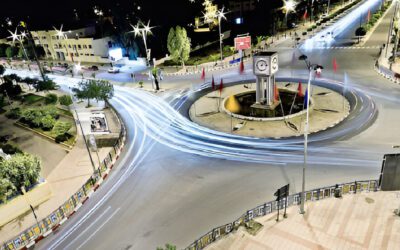Chefchaouen The Blue City Of Morocco
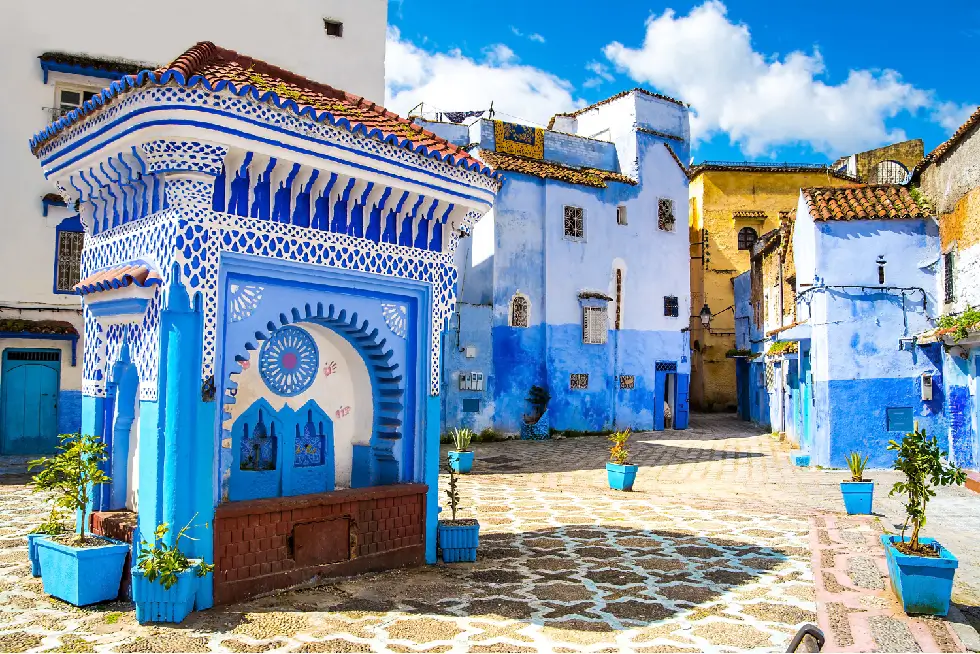
Table of Contents:
Introduction to Chefchaouen
Chefchaouen the blue city of Morocco, is Known by many as Chaouen, which translates to ‘look at the horns’ in the Tamazigh language, by Sīdī ʿAlī ibn Rashīd.
The Blue Pearl City is situated in the Tanger–Tetouan–Al Hoceima region of Morocco, it sits in the rugged terrain of the Rif Mountains, Established in 1471 as a humble settlement, it became a sanctuary for Moors and Jews fleeing the Reconquista of Spain.
this small hillside city enchants every traveler with its blue-tinted charm. As you step into its precincts, The tradition of blue-painted buildings, a reflection of the sky and heavens, invites visitors into a calm and tranquil world, offering a piece of serenity amidst the rugged landscapes of northern Morocco.
Chefchaouen Tour Guide
Highlighted below are some remarkable sites and activities that establish Chefchaouen as a destination worthy of a visit:
Wander through the Old City and Medina
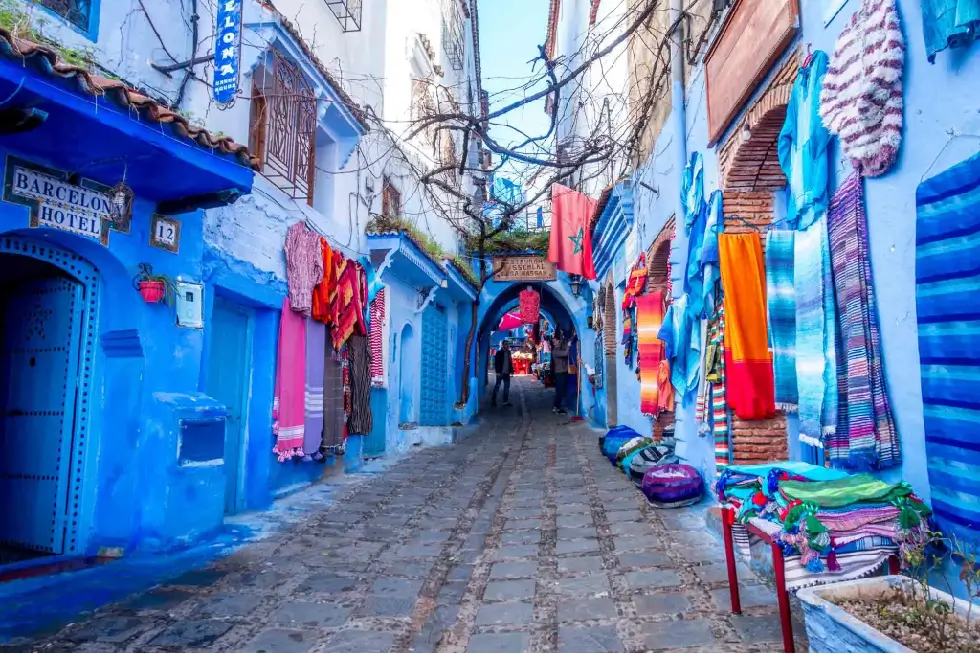
The essence of Chefchaouen resides in its old city and medina, characterized by blue-tinted structures, labyrinthine narrow lanes, and a conventional souk. This area is a shopper’s delight, particularly for those interested in local leather goods and other authentic souvenirs. The laid-back atmosphere here attracts numerous visitors.
Explore the Kasbah Museum
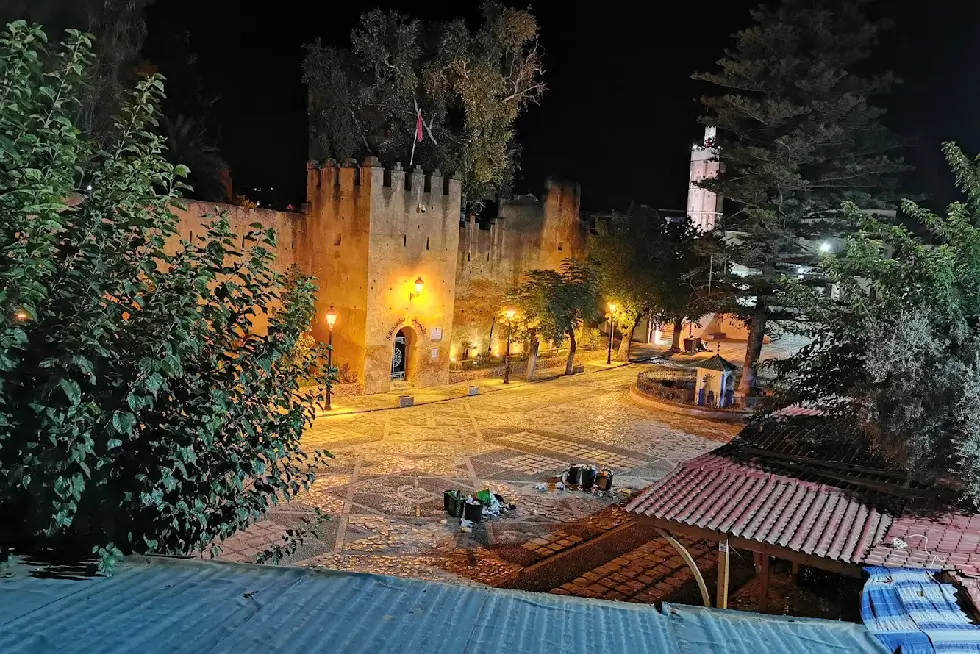
Nestled in the medina’s core, the Kasbah Museum showcases a range of artifacts from the Chefchaouen area, all set within a picturesque Andalusian garden. This museum provides a glimpse into the local history and cultural heritage.
Trek in the Rif Mountains
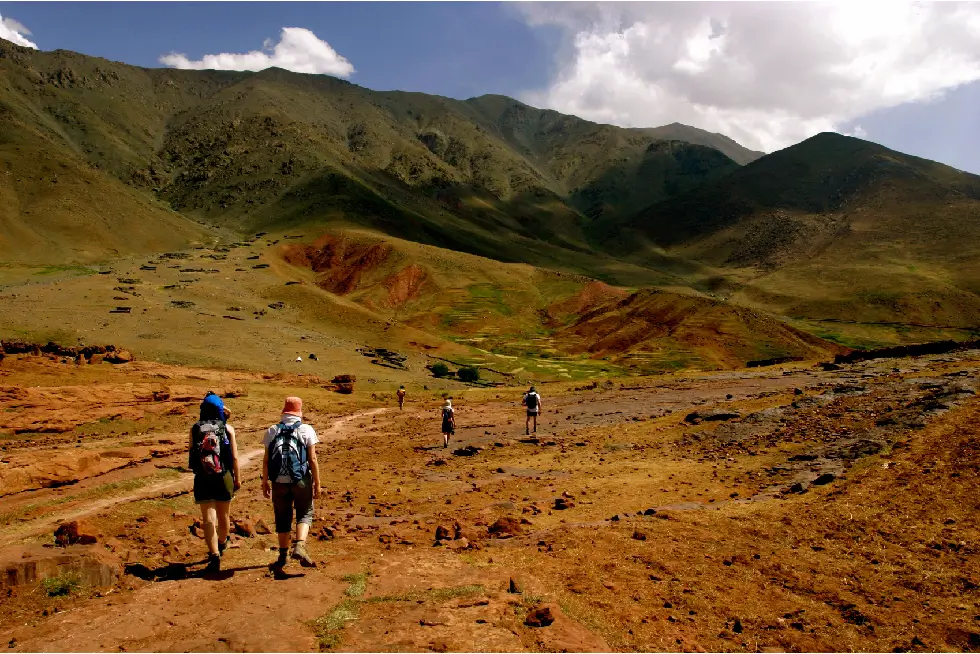
Nature aficionados will find the trails in the Rif Mountains to be a gateway to viewing Chefchaouen from a new angle. These paths unveil breathtaking panoramic vistas of the town and its environs. A notable expedition is the two-day venture to the Talasemtane National Park.
Uncover the Beauty of Cascades d’Akchour
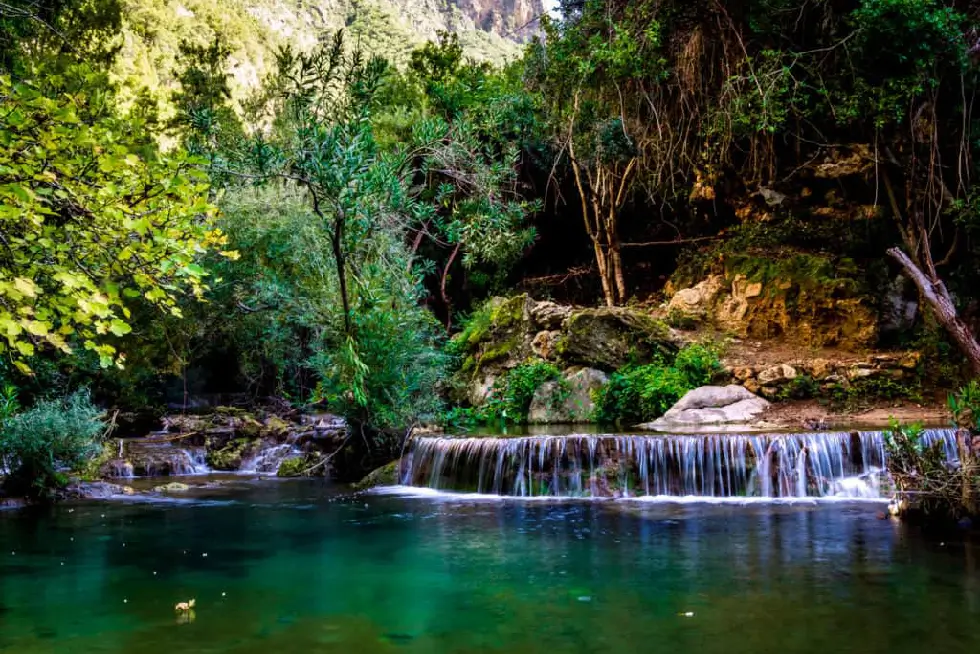
A brief taxi journey from Chefchaouen will take you to Cascades d’Akchour, a visually appealing locale adorned with waterfalls and rock pools. It’s an ideal spot for nature walks and a rejuvenating swim in the rock pools. The “Bridge of God,” a natural arch over the river, adds a touch of awe to the scenery.
Admire the Grand Mosque
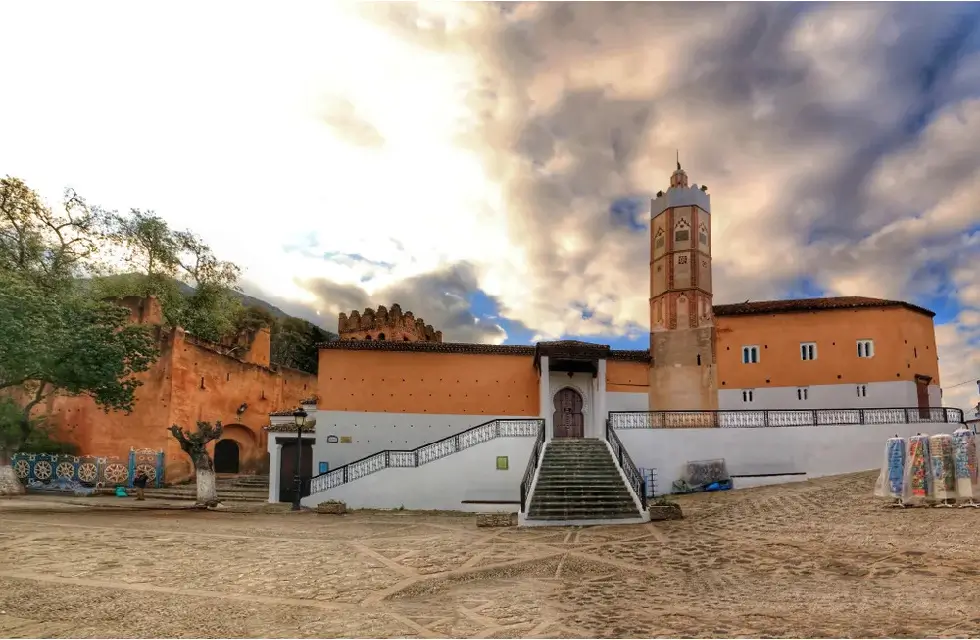
The Grand Mosque of Chefchaouen, with its distinct octagonal minaret, stands as a notable landmark in Plaza Uta El Hammam. Erected in the 15th century, it exemplifies classic Moroccan architectural design.
Savor the Serenity of the Andalusian Garden in the 15th-century Kasbah
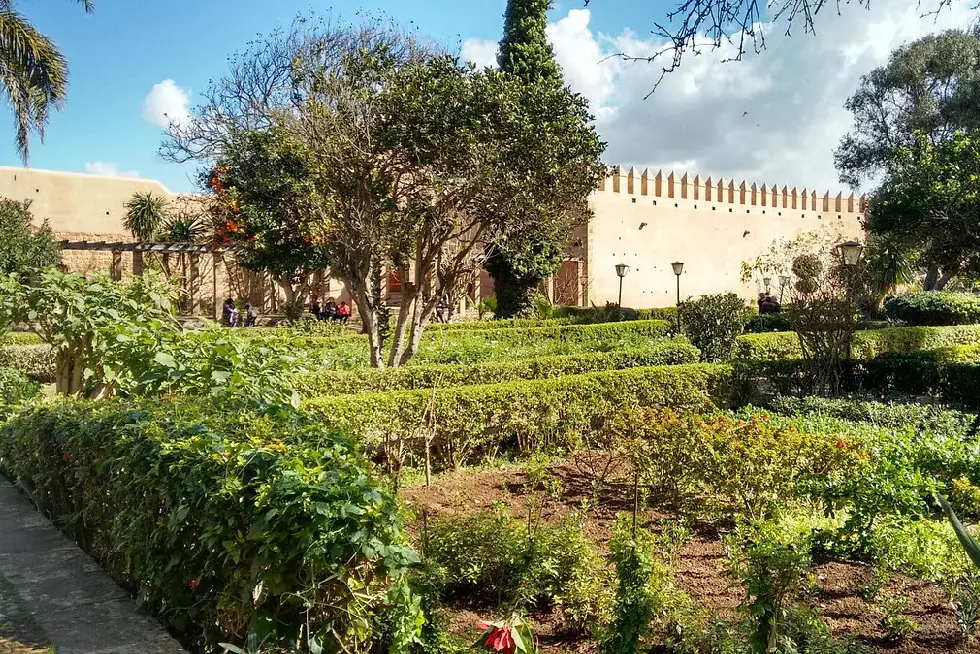
The Kasbah, apart from housing the museum, also encloses a charming Andalusian-style garden. It’s a peaceful haven to relax and soak in the verdancy amidst the blue-hued city.
Chefchaouen Transportation System
Navigating to and around Chefchaouen necessitates a touch of pre-planning. Here’s a snapshot of the transport avenues at your disposal both to and within Chefchaouen:
Arriving in Chefchaouen:
1. From Key Urban Hubs:
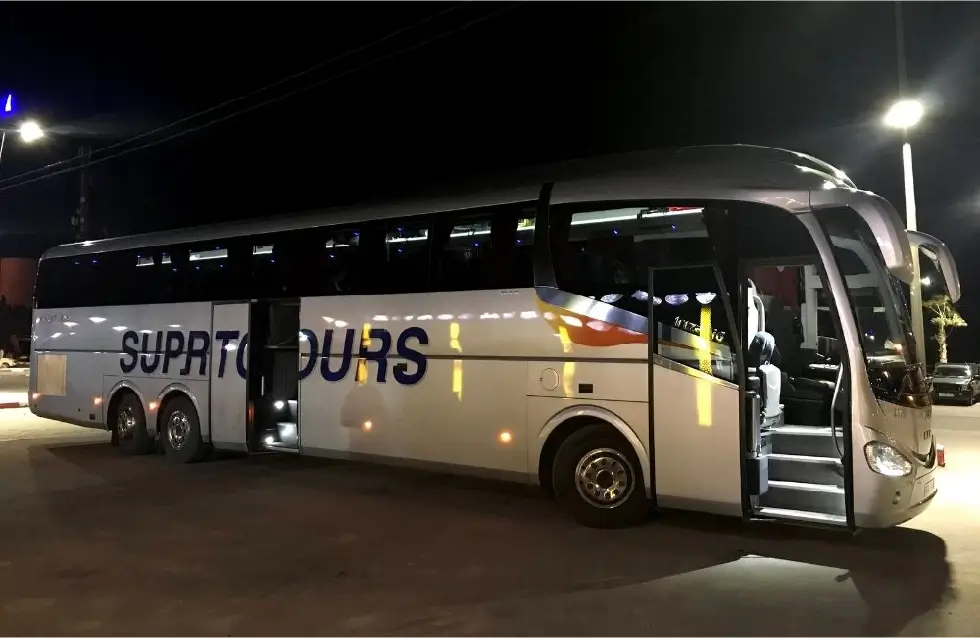
- Journey from Tangier to Chefchaouen:
- By Bus: Opting for bus services like those provided by CTM is a common choice, with a journey duration of roughly 2.5 hours, priced at about 112 MAD (approximately 11 USD) per individual.
- By Taxi: Shared taxi rides are prevalent, taking close to 2 hours at a cost of around 100 MAD (nearly 11 USD) per passenger. For a private experience, hiring an entire taxi is an option at around 1,266 MAD (about 124 USD).
- By Personal Vehicle: Securing a rented vehicle or arranging a private transfer offers more autonomy albeit at a higher price point. Car rentals hover around 670 MAD (roughly 66 USD) for a week, exclusive of petrol and toll charges.
- Comparable transit options are accessible from other significant cities like Fes, Rabat, and Casablanca en route to Chefchaouen.
2. Air Voyage:
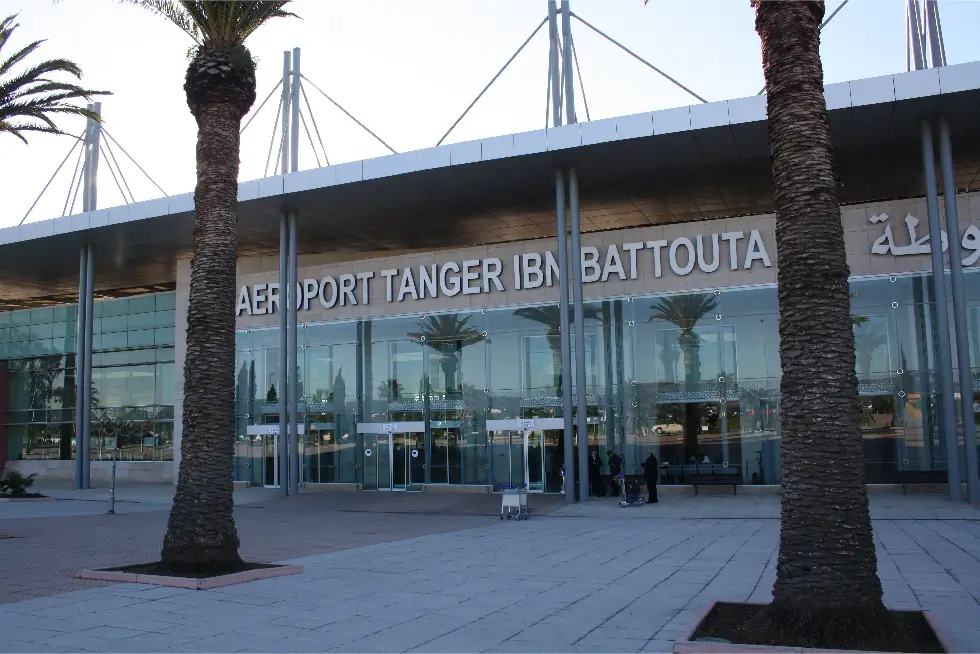
- Tangier Ibn Battouta Airport is the nearest airstrip to Chefchaouen.
3. Rail Travel:
- Though Chefchaouen lacks a train terminal, voyagers can alight at a station in a proximate city like Tangier, and then transition to other transport means to reach Chefchaouen.
Maneuvering Within Chefchaouen:
1. Taxis and Shuttles:
- These vehicles serve as favored modes of local transit. They facilitate convenient movement around Chefchaouen, aiding in the exploration of its myriad attractions.
2. On Foot:
- Chefchaouen’s modest dimensions make traversing its lanes on foot both practical and pleasurable.
Reserving Transit:
- Due to its secluded locale and the finite transport facilities, it’s prudent to secure your transport arrangements to and from Chefchaouen beforehand. The high demand for transit could lead to unavailability on successive days, possibly necessitating a revision of your travel itinerary.
Chefchaouen Shopping Extravaganza
Engaging in a retail adventure in Chefchaouen, the enchanting blue hamlet of Morocco, is comparable to setting sail on a treasure expedition amidst a labyrinth of quaint cobblestone pathways. Here’s a glimpse into the marvels that fashion shopping in Chefchaouen into a grand spectacle:
Unique Finds:
1. Woolen Goods and Fabrics:
Chefchaouen is renowned for its woolen creations and textiles. The town serves as an excellent hub for acquiring handcrafted blankets and wool attire, items less frequently found in other Moroccan locales.
Notable Retail Corners:
1. Ensemble Artisanal Marrakech:
Nestled in a locale known as El Makhzen in Chefchaouen, Ensemble Artisanal Marrakech unfolds as an enthralling haven for visitors. Bargain hunters can snag Riffi blankets among other items at unchanging price points here.
2. The Medina:
A shopping jaunt in the Medina is essential. While sauntering through its blue-shaded alleys, a myriad of boutiques unveiling traditional Moroccan artifacts await.
Diverse Shopping Outlets:
1. Gift Boutiques, Antique Repositories, and Fashion Excursions:
Chefchaouen presents a spectrum of retail outlets encompassing gift boutiques, antique repositories, and fashion excursions. This medley attends to varied retail predilections, be it a quest for mementos, age-old treasures, or an immersion into the local couture panorama.
Retail Expeditions
For those keen on delving deeper into the retail landscape, partaking in a shopping expedition emerges as a splendid avenue to unearth local handiwork and keepsakes.
Chefchaouen Architecture
The architecture of Chefchaouen, a quaint town nestled in the Rif mountains of Morocco, is a blend of Andalusian, Moorish, and Moroccan styles, which reflects the town’s rich history and the various cultures that have influenced its development over the centuries. Here’s a delve into the architectural charisma of Chefchaouen:
Distinct Architectural Traits:
1. Blue-Washed Buildings:
The town’s emblematic blue-washed buildings not only earmark it as one of the globe’s most colorful havens but also craft a tranquil and cool aura that sets it apart from other Moroccan settlements.
2. Andalusian-Maghrebian Influence:
The architectural panorama of the town is deeply rooted in the Andalusian-Maghrebian style, prominently showcased in the 15th-century Kasbah constructed by the town’s progenitor. This style melds elements like arches, domes, pillars, and parapets, embodying the quintessence of Moorish architecture.
Architectural Landmarks:
1. Bab el Ain:
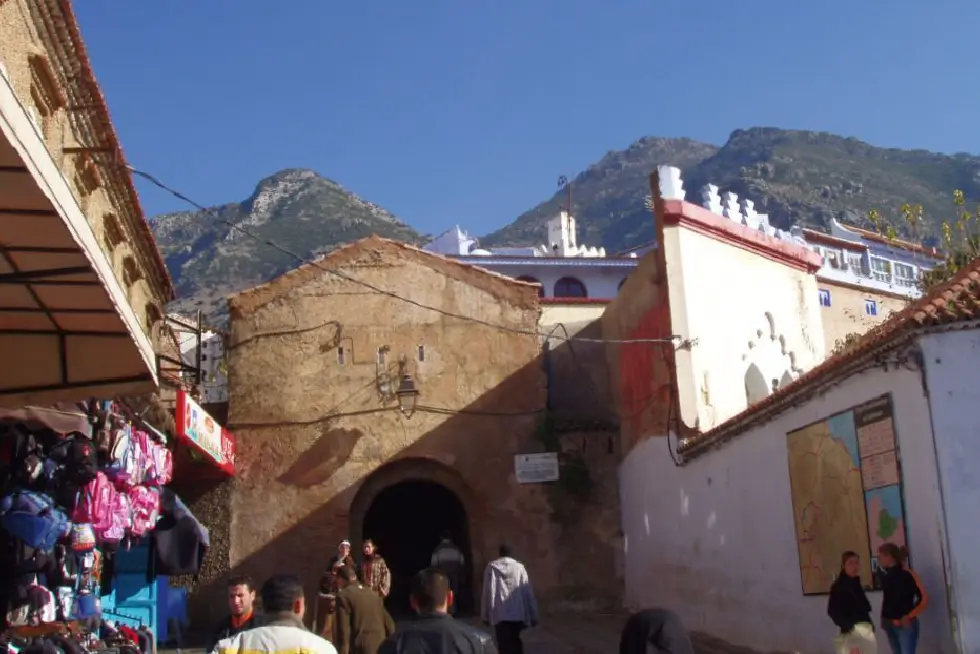
Acting as a principal portal into the historic 15th-century medina, Bab el Ain flaunts a majestic terracotta-hued stone facade with a diminutive archway and windows, encapsulating the essence of traditional Moroccan architectural design.
2. The Kasbah:
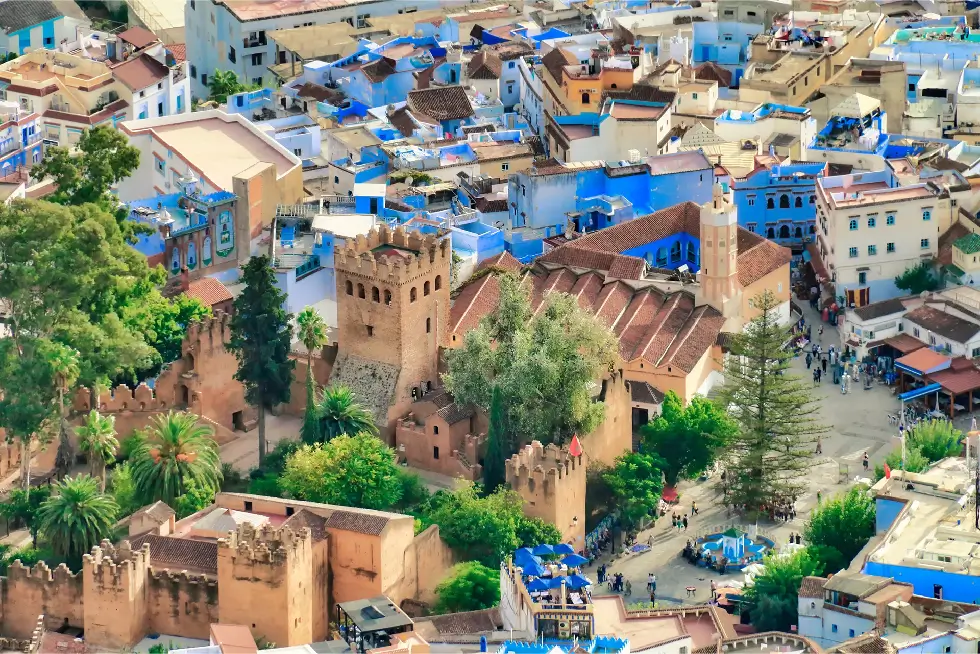
The Kasbah, with roots tracing back to between the 15th and 16th centuries, stands not only as an architectural spectacle but also as a historic symbol of Chefchaouen’s defiance against foreign assaults. Now harboring the Ethnographic Museum, the Kasbah’s Andalusian-Maghrebian architectural ethos, and its 11 towers offer a nostalgic voyage as well as sweeping vistas of the locale.
3. Spanish Mosque:
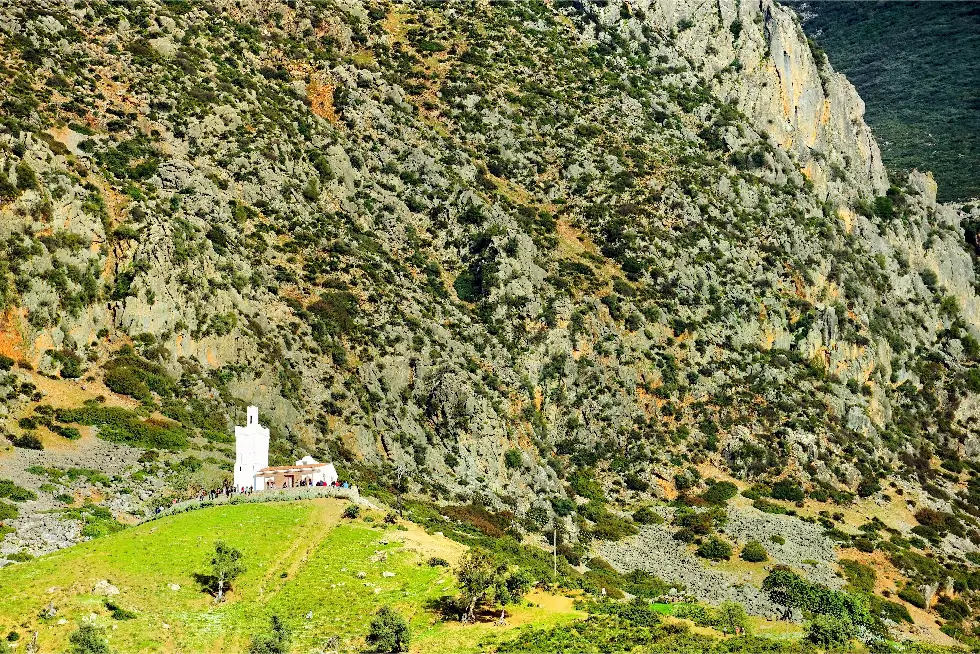
Erected in the 1920s by Spanish hands, this white-washed mosque atop a hill unveils an evocative peek into the architectural imprints of foreign entities in Chefchaouen. Although it descended into disrepair due to sparse local attendance, subsequent restoration endeavors have revived its architectural charm.
Chefchaouen Economic Significance
The Moroccan blue city of Chafchaouen has a diversified economy rooted in traditional agro-pastoral systems and boosted by its emerging status as a sustainable city. Here’s a dive into its economic significance:
Roots in Agriculture and Craftsmanship:
The economic essence of Chefchaouen has long been intertwined with agriculture and the art of craftsmanship. The locale is renowned for its lush olive and fig orchards, supported by a plethora of water mills engineered for the grinding of grain and olives. Moreover, a flourishing sector dedicated to the craftsmanship of leather, iron, textiles, and carpentry adds a unique flavor to its economic tapestry.
Tourism’s Economic Impact:
Tourism significantly fuels Chefchaouen’s economy, bequeathing it the title “The Blue Pearl of Morocco” owing to its iconic blue-painted edifices. The city’s enchanting aesthetic, melded with its tranquil mountainous backdrop, lures a myriad of visitors each year. Tourism revenue markedly bolsters the local economy, with initiatives underway to augment the living standards for both residents and tourists, notably through urban environment enhancements and the advocacy for eco-friendly transit options.
Stride Towards Sustainability:
In the recent past, Chefchaouen has embarked on an odyssey towards epitomizing a sustainable city, aligning its economic endeavors with the ethos of environmental conservation and sustainable development aspirations. The city champions sustainable energy via solar-powered installations, robust waste management, and recycling initiatives. Furthermore, it fosters e-mobility solutions like electric buses to mitigate carbon footprints and has inaugurated a consultative energy council to foster community engagement in its sustainability agenda. These ventures not only catalyze a greener economy but also propel Chefchaouen into the limelight as a vanguard of sustainable urban centers in Africa, in turn, drawing eco-aware tourists and global sustainability circles.
Historical Trade Significance:
In bygone eras, Chefchaouen’s strategic geographical locus at the juncture of trade routes between Fez and Ceuta bestowed upon it a pivotal role in regional trade and commerce dynamics.
Cultural and Gastronomic Endeavours:
The Mediterranean Diet, hailed worldwide for its health-promoting and sustainable attributes, finds a home in Chefchaouen, thereby contributing to a holistic sustainable development encompassing economic, social, cultural, and environmental facets in the vicinity.
Chefchaouen Historical Overview
Chefchaouen, often referred to as the blue city due to its blue-painted buildings, has a rich history that dates back to the 15th century. Here’s an overview of its historical journey:
Often heralded as the blue city due to its distinctive blue-hued edifices, Chefchaouen’s rich tapestry of history unfolds back to the 15th century. Here’s a snapshot of its historical voyage:

Foundation:
Established in 1471, initially serving as a modest fortress, Chefchaouen arose as a bulwark against Portuguese forays after their annexation of Ceuta. The city’s inception is attributed to Moulay Ali Ben Moussa Ben Rached El Alami, a lineage holder of the Islamic Prophet Muhammad, albeit another narrative credits a warrior named Abū Youma for its foundation.
Early Development:
Chefchaouen was birthed to act as a bastion against Portuguese intrusions. Yet, its geographically strategic placement earmarked it as a pivotal hub along the region’s commercial trails. The epoch of 1492, marked by the fall of Granada, saw Chefchaouen opening its arms to Muslims and Jews seeking refuge from the Iberian Peninsula, thereby playing a significant role in its developmental trajectory.
Spanish Occupation:
Enveloped under Spanish rule in 1920, Chefchaouen only re-emerged under the Moroccan realm in 1956, post Morocco’s emancipation. This interim etched a lasting imprint on the city’s persona, weaving a unique tapestry of Moroccan and Andalusian architectural and cultural semblances.
Architectural Heritage:
Chefchaouen’s historical narrative is deeply enshrined within its architectural lineage. The town’s Kasbah, constructed in 1471, remains a living testament to its primitive history. Initially erected as a fortress to shield against potential onslaughts, it now stands as a distinguished historical and tourist landmark.
Spiritual Connotation:
Conceived as a sacred enclave, Chefchaouen has nurtured its spiritual ethos across the ages. It also served as a haven for Moors expelled from Spain, thereby augmenting its religious and cultural heterogeneity.
Conclusion
Chefchaouen is a blend of historical significance, cultural richness, and natural beauty, making it a unique and captivating destination in Morocco. Whether interested in history, shopping, cuisine, or adventure, visitors to Chefchaouen will find a vibrant and welcoming community nestled amidst the breathtaking landscape of the Rif Mountains.
FAQ
Why are the Buildings in Chefchaouen Blue?
The tradition of blue-painted buildings is said to be a reflection of the sky and heavens. It creates a calm and tranquil atmosphere, setting Chefchaouen apart from other cities.
How Do I Reach Chefchaouen?
Chefchaouen can be accessed by bus or taxi from key cities like Tangier, Fes, Rabat, and Casablanca. The nearest airport is Tangier Ibn Battouta Airport.
What is the Best Time to Visit Chefchaouen?
The best time to visit depends on personal preferences. The city has a generally mild climate year-round, but it’s advisable to check current weather conditions and local festivals for a complete experience.
What is Chefchaouen Known for?
Chefchaouen, also referred to as Chaouen, is renowned for its blue-tinted buildings and streets. It’s a charming city in Morocco’s Rif Mountains known for its serene atmosphere, rich history, and unique architecture.
What is the Historical Significance of Chefchaouen?
Established in 1471, Chefchaouen was initially a fortress. It became a sanctuary for Moors and Jews fleeing the Reconquista of Spain, influencing its cultural and architectural development.
Can I Explore Chefchaouen on Foot?
Yes, the city’s modest size makes it ideal for exploring on foot, especially within the old city and medina with its narrow, labyrinthine lanes.
What are Some Must-Visit Sites in Chefchaouen?
Key sites include the Old City and Medina, the Kasbah Museum, the Rif Mountains, the Cascades d’Akchour, the Grand Mosque, and the Andalusian Garden in the Kasbah.
What Are the Local Shopping Specialties in Chefchaouen?
Chefchaouen is known for its woolen goods, fabrics, and unique handicrafts. The Ensemble Artisanal Marrakech and the Medina are notable shopping spots.
What Architectural Styles are Prominent in Chefchaouen?
The architecture is a blend of Andalusian, Moorish, and Moroccan styles, featuring blue-washed buildings, arches, domes, and ornate interiors.
Is There Any Historical Landmark in Chefchaouen?
Yes, the Kasbah, built in the 15th century, is a significant historical and architectural landmark. Other notable landmarks include Bab el Ain and the Spanish Mosque.
What is the Economic Basis of Chefchaouen?
The economy is based on agriculture, craftsmanship, and tourism. Chefchaouen is also making strides towards becoming a sustainable city with a focus on eco-friendly initiatives.
Are There Luxury Accommodations in Chefchaouen?
Yes, for a luxurious stay, the Lina Riad and Spa in the Medina offers traditional Moroccan hammam and massage services.
Is Chefchaouen Suitable for Family Travel?
Yes, Chefchaouen is family-friendly, offering a safe, tranquil environment with activities and sights that appeal to all ages.
Are There Guided Tours Available in Chefchaouen?
Yes, guided tours are available and are a great way to learn about the city’s history, culture, and hidden gems.
How Should I Plan My Transportation Within Chefchaouen?
Taxis and shuttles are recommended for longer distances, but much of the city can be comfortably explored on foot. Pre-booking transportation is advisable, especially during peak tourist seasons.


